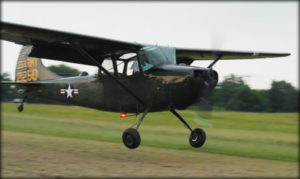Project Description

MPH
WEAPONS
SEATS
Cessna L-19 “Bird Dog”
Role: Observation aircraft
National Origin: United States
Manufacturer: Cessna
First Flight: 1950
Primary User: US Army, US Air Force, US Marine Corps, Royal Thai Air Force
Number Built: 3431
The U.S. Army was searching for an aircraft that could adjust artillery fire, as well as perform liaison duties, and preferably be constructed of all metal, as the fabric-covered liaison aircraft used during World War II (primarily Stinson and Piper products) had short service lives. The U.S. Army issued the specification for a two-seat liaison and observation monoplane, and the Cessna Aircraft Company submitted the Cessna Model 305A, a development of the Cessna 170. The Cessna 305A was a single-engine, lightweight, strut-braced, high-wing monoplane with a tail wheel landing gear. The greatest difference from the Cessna 170 was that the 305A had only two seats, in tandem configuration (the largest tandem-seat aircraft Cessna ever produced), with angled side windows to improve ground observation.
General characteristics
- Crew: One/Two
- Length: 25 ft 10 in (7.88 m)
- Wingspan: 36 ft 0 in (10.97 m)
- Height: 7 ft 4 in (2.23 m)
- Wing area: 174 sq ft[25] (16.16 m²)
- Empty weight: 1,614 lb (734 kg)
- Max. takeoff weight: 2,430 lb (1105 kg)
- Powerplant: 1 × Continental O-470-11 flat six piston, 213 hp (159 kw)
Performance
- Maximum speed: 115 mph (100 knots, 185 km/h)
- Cruise speed: 104 mph (87 knots, 167 km/h)
- Stall speed: 54 mph (47 knots, 87 km/h)
- Range: 530 miles (460 nmi, 853 km)
- Service ceiling: 18,500 ft (5,640 m)
- Rate of climb: 1,150 ft/min (5.8 m/s)
- Take-off distance to 50 ft (15 m): 560 ft (170 m)
- Landing distance from 50 ft (15 m): 600 ft (180 m)